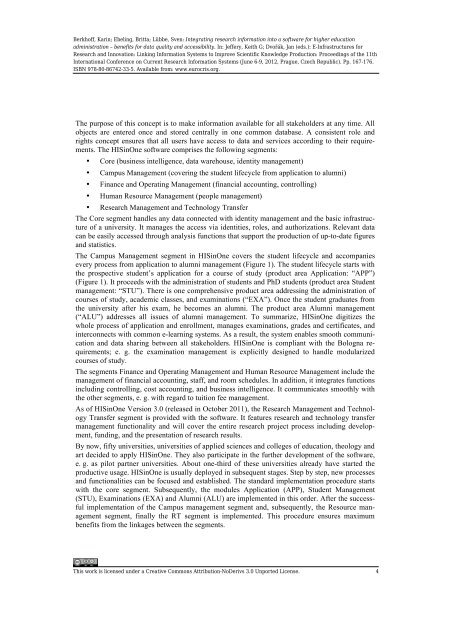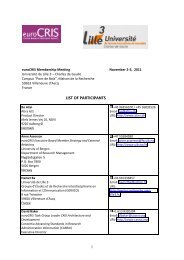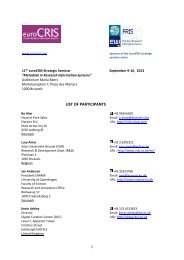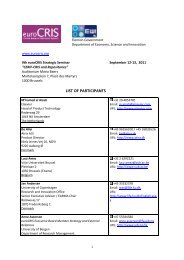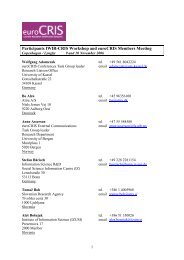Paper - EuroCRIS
Paper - EuroCRIS
Paper - EuroCRIS
You also want an ePaper? Increase the reach of your titles
YUMPU automatically turns print PDFs into web optimized ePapers that Google loves.
Berkhoff, Karin; Ebeling, Britta; Lübbe, Sven: Integrating research information into a software for higher education<br />
administration – benefits for data quality and accessibility. In: Jeffery, Keith G; Dvořák, Jan (eds.): E-Infrastructures for<br />
Research and Innovation: Linking Information Systems to Improve Scientific Knowledge Production: Proceedings of the 11th<br />
International Conference on Current Research Information Systems (June 6-9, 2012, Prague, Czech Republic). Pp. 167-176.<br />
ISBN 978-80-86742-33-5. Available from: www.eurocris.org.<br />
The purpose of this concept is to make information available for all stakeholders at any time. All<br />
objects are entered once and stored centrally in one common database. A consistent role and<br />
rights concept ensures that all users have access to data and services according to their requirements.<br />
The HISinOne software comprises the following segments:<br />
• Core (business intelligence, data warehouse, identity management)<br />
• Campus Management (covering the student lifecycle from application to alumni)<br />
• Finance and Operating Management (financial accounting, controlling)<br />
• Human Resource Management (people management)<br />
• Research Management and Technology Transfer<br />
The Core segment handles any data connected with identity management and the basic infrastructure<br />
of a university. It manages the access via identities, roles, and authorizations. Relevant data<br />
can be easily accessed through analysis functions that support the production of up-to-date figures<br />
and statistics.<br />
The Campus Management segment in HISinOne covers the student lifecycle and accompanies<br />
every process from application to alumni management (Figure 1). The student lifecycle starts with<br />
the prospective student’s application for a course of study (product area Application: “APP”)<br />
(Figure 1). It proceeds with the administration of students and PhD students (product area Student<br />
management: “STU”). There is one comprehensive product area addressing the administration of<br />
courses of study, academic classes, and examinations (“EXA”). Once the student graduates from<br />
the university after his exam, he becomes an alumni. The product area Alumni management<br />
(“ALU”) addresses all issues of alumni management. To summarize, HISinOne digitizes the<br />
whole process of application and enrollment, manages examinations, grades and certificates, and<br />
interconnects with common e-learning systems. As a result, the system enables smooth communication<br />
and data sharing between all stakeholders. HISinOne is compliant with the Bologna requirements;<br />
e. g. the examination management is explicitly designed to handle modularized<br />
courses of study.<br />
The segments Finance and Operating Management and Human Resource Management include the<br />
management of financial accounting, staff, and room schedules. In addition, it integrates functions<br />
including controlling, cost accounting, and business intelligence. It communicates smoothly with<br />
the other segments, e. g. with regard to tuition fee management.<br />
As of HISinOne Version 3.0 (released in October 2011), the Research Management and Technology<br />
Transfer segment is provided with the software. It features research and technology transfer<br />
management functionality and will cover the entire research project process including development,<br />
funding, and the presentation of research results.<br />
By now, fifty universities, universities of applied sciences and colleges of education, theology and<br />
art decided to apply HISinOne. They also participate in the further development of the software,<br />
e. g. as pilot partner universities. About one-third of these universities already have started the<br />
productive usage. HISinOne is usually deployed in subsequent stages. Step by step, new processes<br />
and functionalities can be focused and established. The standard implementation procedure starts<br />
with the core segment. Subsequently, the modules Application (APP), Student Management<br />
(STU), Examinations (EXA) and Alumni (ALU) are implemented in this order. After the successful<br />
implementation of the Campus management segment and, subsequently, the Resource management<br />
segment, finally the RT segment is implemented. This procedure ensures maximum<br />
benefits from the linkages between the segments.<br />
This work is licensed under a Creative Commons Attribution-NoDerivs 3.0 Unported License. 4


